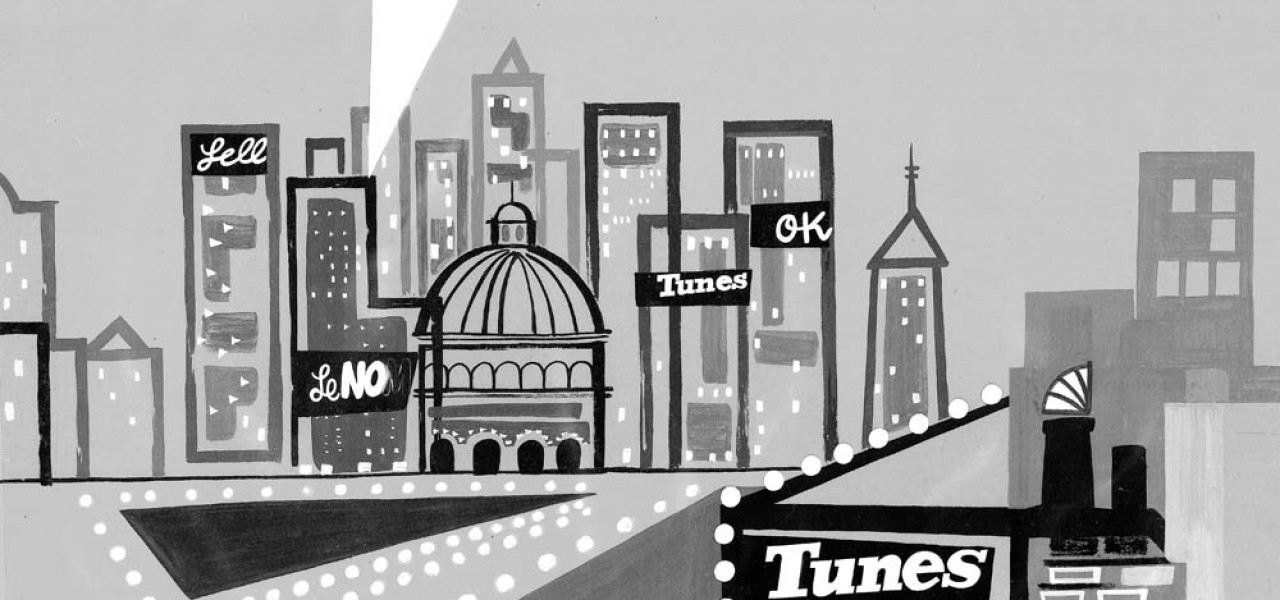
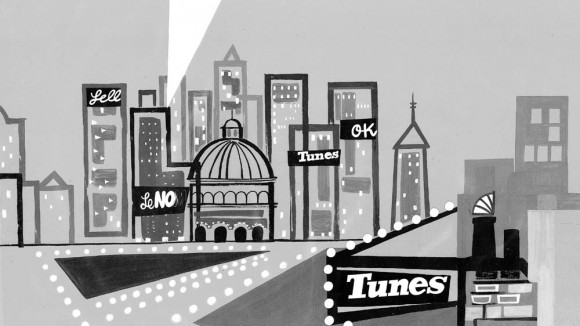
When Amsterdam Went UPA: Dutch Modern Cartoons in the 1950s
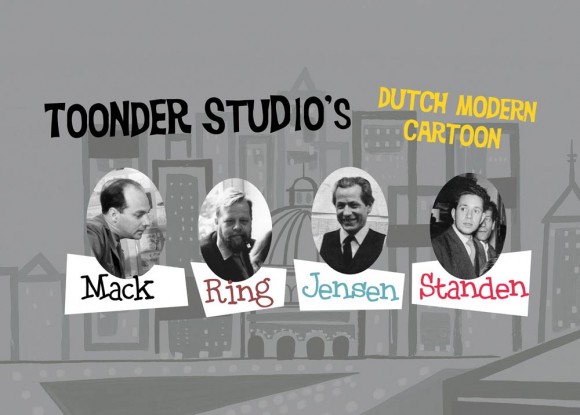
JAN-WILLEM DE VRIES has written several books and articles about the Toonder Animation Studio’s. One of his future publications might be an extensive (and heavily illustrated) chronicle of the studio in the 1950s, describing more about the careers of the artists discussed in this piece, as well as the company’s ink-and-paint department and its enormous output of TV commercials.
Strictly speaking, the term ‘Dutch modern cartoons’ is a little misleading. They were made in Holland, yes. The head of the studio was the Dutch artist Marten Toonder, yes. The ink-and-paint department was run by the Dutch and the camera was operated by Dutch hands.
But the major stars in our story are four artists who came from England and Denmark. They were the heart and soul of the animation department at Toonder Studio’s in the 1950s.
From England came Harold Mack and Alan Standen, from Denmark Børge Ring and Bjørn Frank Jensen. All were animation directors, except for Standen who was a background artist. Of these artists Børge Ring is best known. He won an oscar for his short Anna and Bella in 1984, and in 2012, his efforts in animation were rewarded with the Winsor McCay Award.
Mack, Standen, Ring and Jensen expressed great interest in the innovations that United Productions of America brought to the animation industry. They adapted some of the styles they saw in UPA shorts like Gerald McBoing Boing and Rooty Toot Toot because it was a request of the studio’s customers (mostly television advertisers), but also because they embraced the new art form. But who was this quartet of artists? And what were they doing in Amsterdam?
Building the Team
The Toonder Studio’s (the misplaced apostrophe was part of its name) was founded in Amsterdam in 1941. Marten Toonder was an illustrator and a comic artist with a fond interest in animation. His comics were extremely successful in the Netherlands and this gave him the opportunity to hire artists to work for him. After a rough start during World War II Toonder tried to develop a full-length animation feature in 1949. He invested too much in the project and his studio got into financial trouble. Most of his animators left to start working in the puppet animation studio Dollywood, founded by Joop Geesink.
Toonder was left with a cameraman, but no animators or background artists. So when the British animator Harold Mack expressed interest in working for him, Toonder hired him on the spot.
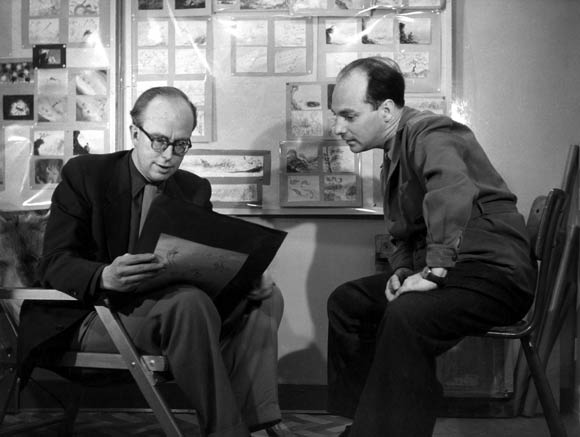
Marten Toonder (left) and Harold Mack
Harold Mack (1918—1974) had previously worked for Halas and Batchelor, David Hand, and George Moreno. He felt isolated in England and traveled to the European mainland where he worked for Julius Pinschewer in Switzerland for a while. Somehow he had seen comics of the Toonder Studio’s and when he learned that its founder was in search of animators he traveled to Amsterdam. Mack was hired together with his wife Pamela. She assisted him and was appreciated for her color design. The couple lived in a house boat in one of the canals in Amsterdam.
In the summer of 1952 Børge Ring (b. 1921) and Bjørn Frank Jensen (1920—2001) joined the Toonder Studio’s. Ring had learned about the place when he was a musician with the Sven Asmussen orchestra. They toured Amsterdam in 1946 and Ring found out that there was an animation studio in the Dutch capital.
Ring had worked for Gutenberghus Reklame Film in Copenhagen where he learned the basics of animation. He became close friends with Bjørn Frank Jensen who got his first animation lessons while working at advertising agency Monte Rossi. While Ring was touring with the orchestra, Jensen worked on the first full-length Danish animation film Fyrtojet (The Tinderbox, 1946). In 1946 Ring and Jensen traveled to England to work for Disney director David Hand (Snow White and the Seven Dwarfs) and his new Animaland series that he was producing for Gaumont British Animation. Hand was a great teacher so the young Ring and Jensen were terribly disappointed when they couldn’t get a work permit and had to return to Denmark after six months. They started their own studio in 1948 and were hired to animate several commercial shorts. Two years later their studio was taken over by Nordisk Film and this lead to frustration.
Ring and Jensen now decided to try their luck with Toonder Studio’s in Amsterdam. The Danes were also negotiating with the United States, through the Marshall Plan, about the creation of six short films. This assignment could now go to the Toonder Studio’s if they hired Ring and Jensen. Needless to say, they were hired right away.
Now Toonder had three solid animators, while the backgrounds were created by artists of his comic department or by the animators themselves. But in November 1953 they were joined by Alan Standen, a young background artist from London. He had a very short resume, but it did include work on Halas and Batchelor’s animated feature Animal Farm (1954). Again, it was an easy decision for Toonder.
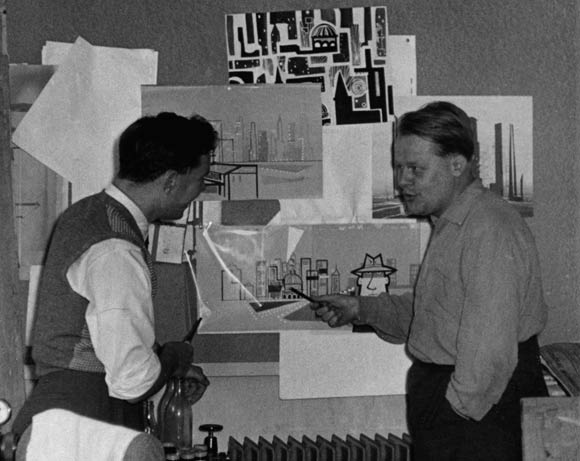
Alan Standen and Børge Ring, 1956
Alan Standen (b. 1929) was advised to visit Halas and Batchelor in the early-1950s to see if he could work on their full-length animated feature based on the book by George Orwell. He was hired as a storyboard artist, but he also provided backgrounds and layouts for the film. Unfortunately Standen did not receive any screen credit because an artist had to be with a union for at least two years in order to get one. Being a rookie, he did not meet those requirements. Near the end of the production Standen spoke to co-director John Reed about his future. Reed suggested that he apply for work with Disney in the United States, or perhaps try France. By this time two delegates from the Toonder Studio’s were in London scouting for a background artist. They were advised to look at Standen’s work and when they met the young artist, he decided to accept their offer to work in Amsterdam.
Going UPA!
In the early 1950s, the UPA studio in Los Angeles and New York City had gained remarkable success with its innovative approach to animated filmmaking. Their films received positive reviews and their designs were noticed in the advertising industry. The Toonder Studio’s were asked if they could provide commercials in a similar style. Mack, Ring, Jensen and Standen were happy to oblige, because they, too, were catching the UPA virus. There was no official term for this new style, so they simply referred to it as the ‘UPA style.’
- Primatour, 1954
- Tunes, 1956
- Guinness Beer, 1956
- Churchmam, 1957
- Gibbs Toothpaste, 1957
- Philips Philishave, 1957
- Kolynos, 1958
- Lokkend goud of gouden lokken, 1958
- Background painting by Alan Standen
The animators quickly tuned into the world of Gerald McBoing Boing and Mr. Magoo. Many of the Magoo shorts were screened in the movie theater ‘De Uitkijk’ in the heart of Amsterdam. One of the things that Mack and his colleagues generously applied to their animation was the use of thick fat outlines combined with thin ones within the same character. Thanks to this design motif, the commercials played well on small black-and-white TV sets. In addition to being a practical consideration for TV, the designs gave great artistic satisfaction to the animators and the background artist.
Later in the 1950s, the crew at Toonder also met with British and American animators when they visited the Cinetone Studio’s in Amsterdam. Among them were Jim Hiltz, Dan McRae and Jimmy Murakami. The Stedelijk Museum in Amsterdam offered a special screening of Modern Cartoons, provided by the American Embassy. The program included shorts like Adventures of an * (1957) by John and Faith Hubley. An academic provided a proper introduction each time the films were shown. Soon he discovered that the screenings were frequently visited by Dutch animation artists. Eventually the speaker did not enter the stage, but stayed near the entrance. He shortened his speech to ‘Is everyone in? Have fun!’
Marten Toonder himself was less satisfied with the developments in his studio. Commercials were now in demand and there was little time to work on short subjects that could satisfy him. Toonder did not see any beauty in TV commercials and eventually he lost interest in the animation department. He moved to Ireland in 1965 where he devoted himself entirely to comics. Despite Toonder’s own misgivings, his studio and an international coalition of artists played a crucial role in modernizing the look of Dutch animation in the 1950s.
A film program of the Cartoon Modern Dutch animation of Toonder Studio’s will screen at the 2013 Klik! Amsterdam Animation Festival on Saturday, November 16, at the EYE Film Institute.

.png)








